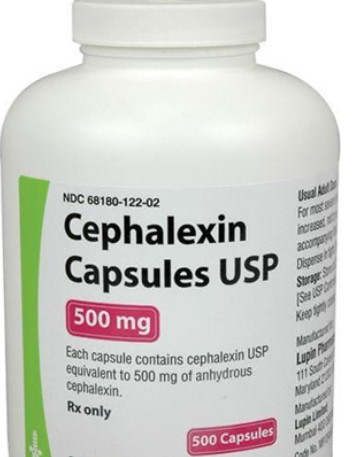
Indications
- Uncomplicated skin and soft tissue infections.
- Impetigo.
- Folliculitis.
- Furuncles.
- Carbuncles.
- Cellulitis.
- Ecthyma.
- Erysipelas.
- Sycosis Barbae.
- Postoperative wound infections.
- Severe infections(iv).
- Complicated cellulitis.
- Necrotizing fasciitis.
Dosage
- Cephalexin : 25–100 mg/kg/day divided q6h or q12h (pediatric dosge) & 250–500 mg 4 times daily (adult dosage).
- Impetigo :250 mg 4 times per day PO (adults) & 25 mg/kg/day in 4 divided doses PO (children).
- Skin And Soft Tissue Infection: (Methicillin-Susceptible S. Aureus): 500 mg 4 times per day PO (adults) & 25 mg/kg/day in 4 divided doses PO (children).
- Non–Purulent Cellulitis:500 mg PO 4 times daily 10-day course.
- Sycosis Barbae : 500 mg four times a day.
- Infections following Animal or Human Bites: 500 mg four times per day.
- Staphylococcus Aureus Suppression In Atopic Dermatitis :Cephalexin 250 mg four times daily 2-week course.
Renal Dosing.
- CrCL 10–40 mL/min: q8–12h.
- CrCl < 10 mL/min: q12–24h.
Side effects
Frequency Not Defined
- Abdominal pain.
- Agitation.
- Anemia.
- Angioedema.
- Confusion.
- Diarrhea.
- Dizziness.
- Dyspepsia.
- Elevated transaminases.
- Eosinophilia hemolytic.
- Epidermal necrolysis.
- Erythema multiform.
- Fatigue.
- Gastritis.
- Genital pruritus.
- Hallucinations.
- Headache.
- Hemolytic anemia.
- Hypersensitivity.
- Nephritis.
- Neutropenia.
- Pseudomembranous colitis.
- Thrombocytopenia.
- Transient hepatitis.
- Toxic epidermal necrolysis.
- Urticaria.
- Vaginal discharge.
- Vomiting.
Contraindications
- Hypersensitivity to drug/class.
Interactions
- Nephrotoxicity: aminoglycosides.
- Increased levels of cephalosporins: probenecid.
- Decreased efficacy of cephalosporins: oral contraceptives.
Pregnancy &Lactation
- Category B.
- Excreted into human milk, Occasionally disruption of the infant’s gastrointestinal flora, resulting in diarrhea or thrush have been reported with cephalosporins, Cephalexin is acceptable in nursing mothers.
Precautions
- Adjust dose in severe renal insufficiency (high doses may cause CNS toxicity).
- Prolonged use is associated with fungal or bacterial superinfection.
- Prolonged treatment, hepatic or renal disease, or nutritional deficiency may be associated with increased international normalized ratio (INR).
- Use with caution in patients with history of hypersensitivity to penicillin.
Drug Info
- Cephalexin is best absorbed from an empty stomach.
- Nail changes have been described following treatment with cephalexin
Was this helpful?
0 / 0
#Cephalexin #Cephalexin uses in dermatology